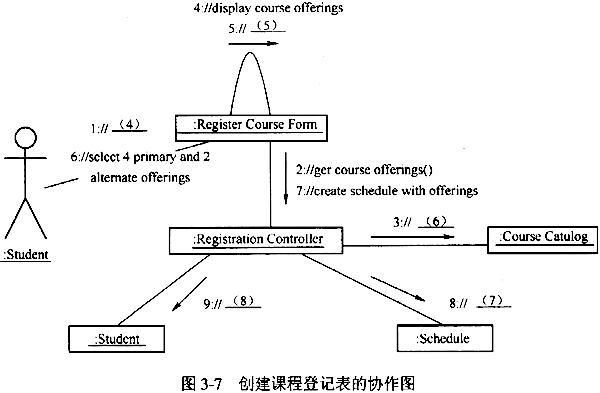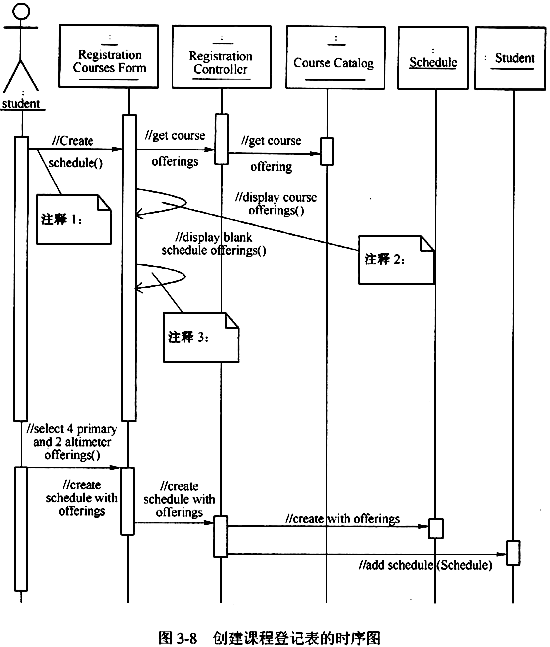女,37岁,上腹部胀痛不适,B超发现肝内占位。
诊断依据是哪些()
A.中年女性,上腹部胀痛不适。
B.T1WI肿瘤表现为均匀的低信号;T2WI肿瘤表现为均匀的高信号
C.随着回波时间延长信号强度增高,出现"灯泡"征
D.病灶强化特点为"早出晚归"型
E.病灶强化由周边开始,并向中心扩展,延迟后,形成高信号肿块,中心可有无强化的不规则低信号区
F.病灶强化程度呈速升速降型,峰值较肝实质高,而持续时间短
参考答案:A, B, C, D, E
女,37岁,上腹部胀痛不适,B超发现肝内占位。
诊断依据是哪些()
A.中年女性,上腹部胀痛不适。
B.T1WI肿瘤表现为均匀的低信号;T2WI肿瘤表现为均匀的高信号
C.随着回波时间延长信号强度增高,出现"灯泡"征
D.病灶强化特点为"早出晚归"型
E.病灶强化由周边开始,并向中心扩展,延迟后,形成高信号肿块,中心可有无强化的不规则低信号区
F.病灶强化程度呈速升速降型,峰值较肝实质高,而持续时间短
参考答案:A, B, C, D, E
【说明】
某大学准备开发一个学生课程注册系统,学生可以使用该系统查询新学期将开设的课程和讲课教师情况,选择自己要学习的课程进行登记注册,并可以查询成绩单;教师可以使用该系统查询新学期将开设的课程和选课学生情况,并可以登记成绩单;注册管理员使用该系统进行注册管理,包括维护教师信息、学生信息和课程信息等。
在每个学期的开始,学生可以获得该学期的课程目录表,课程目录表列出每门课程的所有信息,诸如基本信息、教师、开课系和选课条件等。
新学期开始前两周为选课注册时间,在此期间学生可以选课注册,并且允许改变或取消注册申请,开学两周后注册管理员负责关闭课程注册。每个学生可以选择不超过4门课程,同时指定2门侯选课程以备主选课程未选上。每门课程最多不能超过10人,最少不能低于3人,低于3人选课的课程将被取消。一旦学生的注册过程完毕,注册系统将有关信息提交收费系统以便学生付费。如果在实际注册过程中名额已满,系统将通知学生在提交课程表之前予以更改。
在学期结束时,学生可以存取系统查看电子成绩单。由于学生成绩属于敏感信息,系统必须提供必要的安全措施以防非法存取。
【用例图】

【表】
表3-1 学生课注册系统的实体类
| 实体类 | 说明 |
| Professor | 学校中讲课的教师 |
| Strdent | 学校中注册课程的学生 |
| Schedule | 学生在新学期选择登记的课程列表 |
| CourseCatalog | 学校所有课程的目录 |
| Course | 课程的基本信息 |
| CourseOffering | 新学期课程的开设信息,如课课教师、时间、地点等信息 |
| 边界类 | 说明 |
| LoginForm | 为教师、学生和注册管理提供登录的操作 |
| RegisterCoursesForm | 为学生提供选课注册的操作 |
| ViewReportForm | 为学生提供成绩查询的操作 |
| SelectTeachCoursesForm | 为教师提供查看学生选课情况的操作 |
| SubmitGradesForm | 为教师提供登记成绩的操作 |
| MaintainProfessorsForm | 为注册管理员提供维护教师信息的操作 |
| MaintainStudentsForm | 为注册管理员提供维护学生信息的操作 |
| MaintainCoursesForm | 为注册管理员提供维护课程信息的操作 |
| CloseRegistrationForm | 为注册管理员提供关闭注册的操作 |
| BillingSystemNotice | 提供与收费系统的信息交换接口 |
| 控制类 | 说明 |
| RegisterCoursesControl | 负责新学期学生的选课登记 |
| ViewReportControl | 负责学生成绩的查询 |
| SelectTeachCoursesControl | 负责新学期课程的学生选择情况 |
| SubmitGradesControl | 负责学生成绩的登记 |
| CloseRegistrationControl | 负责关闭课程注册 |

【时序图】
注释1:学生打算注册新的课程。
注释2:一张这学期可选择的课程列表。
注释3:显示一张为学生选课用的空白登记表。

| 【问题2】 协作图与时序图是同构的,二者表示的都是同样的系统交互活动,只是各自的侧重点不同而已。根据题目提供的信息,指出协作图中(4)~(8)处表示的内容。 |